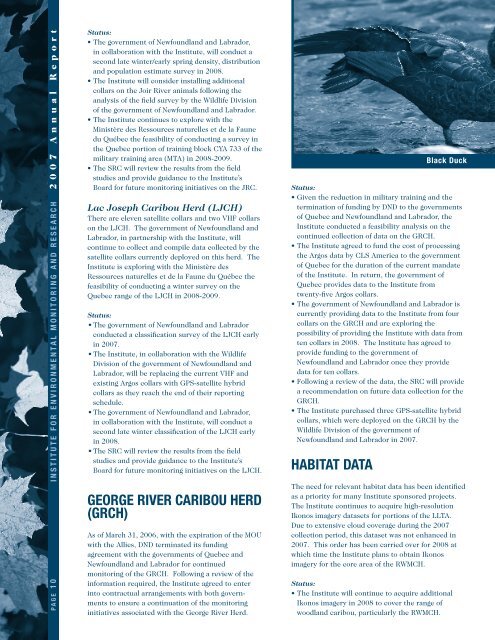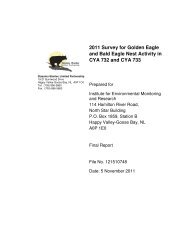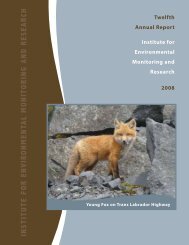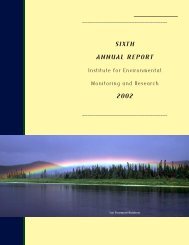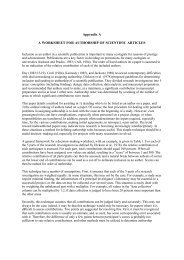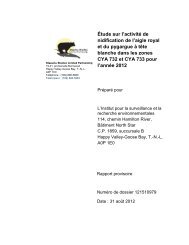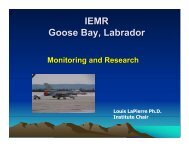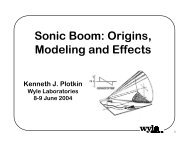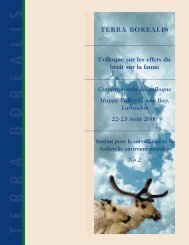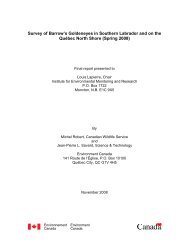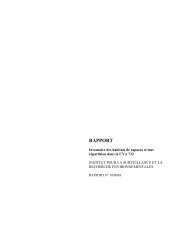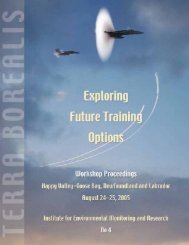2007 Annual Report - Institute for Environmental Monitoring and ...
2007 Annual Report - Institute for Environmental Monitoring and ...
2007 Annual Report - Institute for Environmental Monitoring and ...
- No tags were found...
You also want an ePaper? Increase the reach of your titles
YUMPU automatically turns print PDFs into web optimized ePapers that Google loves.
P a g e 1 0 I n s t i t u t e f o r E n v i r o n m e n t a l M o n i t o r i n g a n d R e s e a r c h 2 0 0 7 A n n u a l R e p o r tStatus:• The government of Newfoundl<strong>and</strong> <strong>and</strong> Labrador,in collaboration with the <strong>Institute</strong>, will conduct asecond late winter/early spring density, distribution<strong>and</strong> population estimate survey in 2008.• The <strong>Institute</strong> will consider installing additionalcollars on the Joir River animals following theanalysis of the field survey by the Wildlife Divisionof the government of Newfoundl<strong>and</strong> <strong>and</strong> Labrador.• The <strong>Institute</strong> continues to explore with theMinistère des Ressources naturelles et de la Faunedu Québec the feasibility of conducting a survey inthe Quebec portion of training block CYA 733 of themilitary training area (MTA) in 2008-2009.• The SRC will review the results from the fieldstudies <strong>and</strong> provide guidance to the <strong>Institute</strong>’sBoard <strong>for</strong> future monitoring initiatives on the JRC.Lac Joseph Caribou Herd (LJCH)There are eleven satellite collars <strong>and</strong> two VHF collarson the LJCH. The government of Newfoundl<strong>and</strong> <strong>and</strong>Labrador, in partnership with the <strong>Institute</strong>, willcontinue to collect <strong>and</strong> compile data collected by thesatellite collars currently deployed on this herd. The<strong>Institute</strong> is exploring with the Ministère desRessources naturelles et de la Faune du Québec thefeasibility of conducting a winter survey on theQuebec range of the LJCH in 2008-2009.Status:• The government of Newfoundl<strong>and</strong> <strong>and</strong> Labradorconducted a classification survey of the LJCH earlyin <strong>2007</strong>.• The <strong>Institute</strong>, in collaboration with the WildlifeDivision of the government of Newfoundl<strong>and</strong> <strong>and</strong>Labrador, will be replacing the current VHF <strong>and</strong>existing Argos collars with GPS-satellite hybridcollars as they reach the end of their reportingschedule.• The government of Newfoundl<strong>and</strong> <strong>and</strong> Labrador,in collaboration with the <strong>Institute</strong>, will conduct asecond late winter classification of the LJCH earlyin 2008.• The SRC will review the results from the fieldstudies <strong>and</strong> provide guidance to the <strong>Institute</strong>’sBoard <strong>for</strong> future monitoring initiatives on the LJCH.George River Caribou Herd(GRCH)As of March 31, 2006, with the expiration of the MOUwith the Allies, DND terminated its fundingagreement with the governments of Quebec <strong>and</strong>Newfoundl<strong>and</strong> <strong>and</strong> Labrador <strong>for</strong> continuedmonitoring of the GRCH. Following a review of thein<strong>for</strong>mation required, the <strong>Institute</strong> agreed to enterinto contractual arrangements with both governmentsto ensure a continuation of the monitoringinitiatives associated with the George River Herd.Status:• Given the reduction in military training <strong>and</strong> thetermination of funding by DND to the governmentsof Quebec <strong>and</strong> Newfoundl<strong>and</strong> <strong>and</strong> Labrador, the<strong>Institute</strong> conducted a feasibility analysis on thecontinued collection of data on the GRCH.• The <strong>Institute</strong> agreed to fund the cost of processingthe Argos data by CLS America to the governmentof Quebec <strong>for</strong> the duration of the current m<strong>and</strong>ateof the <strong>Institute</strong>. In return, the government ofQuebec provides data to the <strong>Institute</strong> fromtwenty-five Argos collars.• The government of Newfoundl<strong>and</strong> <strong>and</strong> Labrador iscurrently providing data to the <strong>Institute</strong> from fourcollars on the GRCH <strong>and</strong> are exploring thepossibility of providing the <strong>Institute</strong> with data fromten collars in 2008. The <strong>Institute</strong> has agreed toprovide funding to the government ofNewfoundl<strong>and</strong> <strong>and</strong> Labrador once they providedata <strong>for</strong> ten collars.• Following a review of the data, the SRC will providea recommendation on future data collection <strong>for</strong> theGRCH.• The <strong>Institute</strong> purchased three GPS-satellite hybridcollars, which were deployed on the GRCH by theWildlife Division of the government ofNewfoundl<strong>and</strong> <strong>and</strong> Labrador in <strong>2007</strong>.HABITAT DATABlack DuckThe need <strong>for</strong> relevant habitat data has been identifiedas a priority <strong>for</strong> many <strong>Institute</strong> sponsored projects.The <strong>Institute</strong> continues to acquire high-resolutionIkonos imagery datasets <strong>for</strong> portions of the LLTA.Due to extensive cloud coverage during the <strong>2007</strong>collection period, this dataset was not enhanced in<strong>2007</strong>. This order has been carried over <strong>for</strong> 2008 atwhich time the <strong>Institute</strong> plans to obtain Ikonosimagery <strong>for</strong> the core area of the RWMCH.Status:• The <strong>Institute</strong> will continue to acquire additionalIkonos imagery in 2008 to cover the range ofwoodl<strong>and</strong> caribou, particularly the RWMCH.


